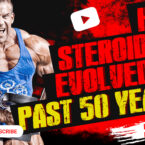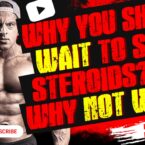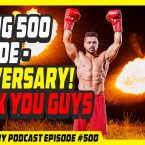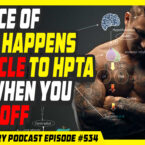Sign up to Get FREE Steroids, SARMS, Peptides eBooks
As you know from my past article "Why Billy Has Breasts", excess testosterone can convert to estrogen - something that bodybuilders definitely don't want - unless you want to look like the guy with the big chest in the movie Fight Club. The Anti-Estrogen Report Card looks at what our options are for preventing this. Enjoy!
Anti-Estrogen Report Card
By J
Remember when you were in school, and you got a report card? If you were like me, you dreaded that time of the semester. I typically got passing grades and on occasion a failing grade that would mean I had to pull straight A’s for the next half of the year in order to avoid repeating a class. What does this have to do with anything?
|
Well I was trying to figure out a way to rate the most commonly used anti-estrogens on the market, and the best way I can think of is to do a report card for them. Why a report card? Well... because it’s pretty easy to understand, first of all. You can be in first place in a race and that’s good, but “1st” on a scale of 1-10 is bad… so lets ditch the number system. I mean… hell… we all know what an “A+” is (or at least, in theory we do), and if you’re anything like me, you certainly know what an “F” is also. So I’m going to rate the most popular anti-estrogens that are available on the market today, with the all-too-familiar school grading system of A - F.
Also, I’d like to state right off the bat that I’m going to mainly be addressing the most commonly discussed and used ancillary compounds on the market today, for use during a cycle. Basically, if you can easily obtain it, you’ll be reading about it in this piece. Sooo... that means if you’re “old school” and are looking for a detailed description of Cytadren or Teslac, you’re out of luck.
So why do we need anti-estrogens? Well, certain anabolic steroids convert to estrogen - this is via the aromatase enzyme, and is called aromatization. This is probably the cause of most of the side effects we experience like bloating, gynocomastia, (possibly) acne, and a host of other side effects we’d rather avoid. Estrogen can also cause additional growth, however, as well as having immunostimulating effects and is beneficial for healthy joints- so it’s important to note that we don’t want to eliminate all estrogen from our bodies.
Anyway, before I get into it, I’m going to have to explain a bit about different types of Anti-Estrogens, ok? First we’ll take a look at SERMs, which stands for “Selective Estrogen Receptor Inhibitor.” There are basically two drugs in this class that we’re going to look at, namely Clomid (Clomiphene Citrate) and Nolvadex (Tamoxifin Citrate).
Basically both of these drugs have the ability to act as an estrogen agonist (or activator, in simpler- though less precise- terms) in some tissue and as an antagonist (inactivator), in others. I’ll get into the specific actions of both of them shortly.
The other class of medications I’m going to explain is Aromatase Inhibitors. Aromatase Inhibitors basically prevent the aromatase enzyme from doing its job.
AIs are classified into two types:
type I, also known as suicidal or noncompetitive inhibitors; and type II, known as competitive inhibitors. Aromasin and ATD are in the first category, while LiquidDex and Letrozole are in the second. Both type I & II mimic substrates (essentially androgens), and can compete with it for access to the binding site on the actual enzyme (aromatase). After this initial binding, the next step is where things begin to differ for the two different types of AI’s. Once a noncompetitive inhibitor has bound, the enzyme initiates a sequence of what’s called hydroxylation, and hydroxylation produces an unbreakable covalent bond between the inhibitor and the enzyme protein. This is important because now, enzyme (aromatase) activity is permanently blocked; even if all of the unattached inhibitor is removed, and now, enzyme activity can only be restored by new enzyme synthesis. Type II AI’s or competitive inhibitors, on the other hand, reversibly bind to the active enzyme site, and one of two effects is had: no enzyme activity is triggered, or the enzyme is somehow triggered without effect. The type II inhibitor can then actually disassociate from the enzyme, eventually allowing renewed competition between the inhibitor and the substrate for binding to the site (estrogen synthesis).
Now that SERMs have been explained as well as AI’s, we can see how each of them rates on my “on-cycle report card.”
Clomid
Clomid is a drug given to women as a fertility aid, which acts by binding to the estrogen receptor and thereby blocking estrogen from doing the same in some tissues. It can bind to breast tissue, and prevent estrogen from binding there to cause gynocomastia -although it is not nearly as effective as nolvadex. It can also stimulate the HPTA (Hypothalamic-Pituitary-Testicular-Axis), and stimulates LH (Luteinizing Hormone) and FSH (Follicle Stimulating Hormone). LH and FSH stimulate the release of testosterone. Unfortunately, Clomid does this only weakly, and there are much better ancillary products on the market. It works, but I think Nolvadex is much better.
Final Grade:C-
Nolvadex
Nolvadex is a Selective Estrogen Receptor Modulator. This means that it acts on the Estrogen receptor (called the "ER" but having nothing to do with George Clooney or Anthony Edwards). Now, this also means that it acts as an estrogen in some tissues which acts as an anti-estrogen in some tissues.
The estrogen receptor's ligand binding domain is just of a number of amino acid sequences "folded" into a series of helixes, which have the ability to change conformation. Different stimuli (such as Nolvadex) are well documented to have the ability to change the conformation of a very important helix (helix 12, for those keeping score at home).
When estradiol binds the ER, this particular helix takes on a conformation that allows DNA transcription to mRNA, and estrogenic effects are then expressed in the body. When Nolvadex (Tamoxifen) binds to it, the antagonist changes the shape of this helix in such a way that it now folds (or bends) in such a way to prevent proper binding of estrogen, and subsequent transcription of DNA to mRNA.
Sadly, if you take progesteronic (I made that word up) steroids and use nolvadex, you may be at an increased risk for progesteronic sides, as nolvadex may increase progesterone receptors (Gynecol Oncol. 1999 Mar;72(3):331-6). So besides competing with estrogen at the receptor, these drugs both increase serum test levels, and both drugs may also alter blood lipid profiles. With regards to Clomid and Nolvadex, I’ve found some research that indicates that 20mgs of tamoxifen is equal to 150mgs of clomid for purposes of testosterone elevation, FSH and LH, but tamoxifen did not decrease the LH response to LHRH (Fertil Steril. 1978 Mar;29(3):320-7). Interestingly, Nolvadex can even be used in small doses just as effectively as larger doses, when it comes to sperm indices and spermatogenesis. (“Effect of lower versus higher doses of tamoxifen on pituitary-gonadal function and sperm indices in oligozoospermic men”. Dony JM, Smals AG, Rolland R, Fauser BC, Thomas CM.)So in this case, we can actually use much lower doses than the egregiously recommended 40-60mgs/day. 5mgs a day seems to be as effective as 20, with regards to basal or LHRH stimulated gonadotropin and testosterone response or the E2/T ratio (Ibid).
So that makes Nolvadex great for preventing gyno, and superb for Post Cycle Therapy even at lower dosages, but not my favorite Ancillary product during a cycle, unless I need to help my lipid profile or just prevent gyno. I give nolvadex a …
Final Grade:B-
Aromasin
Aromasin basically is an aromatase inactivator...It actually makes estrogen receptors useless in a sense, because it inhibits the aromatase enzyme from creating more estrogen. This is like having a wall socket but no radio to plug into it… kind of useless, right? Instead of just inhibiting production (as a Type-II anti-aromatase would do) it irreversibly cuts off estrogen production from the enzyme it attaches to. Aromasin can also cause androgenic sides, so it’s not ideal for women, however. It’s not particularly harsh on cholesterol, and can be effectively used with Nolvadex. I’ve seen studies indicating that it reduces estrogen in your body by about 80%, possibly making it too strong, for maximum gains and staying healthy on a long (12 weeks or more) cycle. Aromasin, at 20mgs/day, will raise your testosterone levels by about 60%, and will even help out your free to bound testosterone ratio by lowering your body’s levels of Sex Hormone Binding Globulin (SHBG), by roughly 20% (The Journal of Clinical Endocrinology & Metabolism Vol. 88, No. 12 5951-5956)… It’s perfect for use in PCT, for many other reasons (it interacts more favorably with Nolvadex than other AIs). But it’s not 100% what we want during a cycle… for this reason, I give it a strong…
Final Grade:B+
LiquidDex
From the research I've done, this seems to be the best ancillary compound around for use on a cycle. First off, 1mg per day of this stuff (J Clin Endocrinol Metab 2000 Jul;85(7):2370-7) was shown to decrease estrogen by about 50% and increase testosterone levels by 58%. That’s a level of estrogen suppression I’m very comfortable with on virtually any cycle. Interestingly, that same study showed that those results were had with .5mgs/day as well. So, since you can elevate testosterone, lower estrogen (but not excessively), and keep healthy joints and lipids, and do this at a half mg per day, I give this my highest rating for an ancillary product to use on a cycle…
Final Grade:A
Letrozole
Letrozole is another type II (competitive) AI. Letrozole is actually a lot more effective than LiquidDex in its ability to pass thru the cell membrane of lipid (fat) cells as well as inhibit the activity of aromatase. In some studies, circulating estrogen levels are totally undetectable in most patients taking Letrozole, and just like LiquidDex, it has even been used in specific cases to increase testosterone to normal levels (from sub-normal ones) and increase LH, and FSH (Epilepsy Behav. 2004 Apr;5(2):260-3). Unfortunately, it does this too well, and although it cleared up my minor gyno lumps, and has been shown to do this in animal studies as well (J Steroid Biochem Mol Biol. 2001 Dec;79(1-5):27-34. Aromatase overexpression transgenic mice model: cell type specific expression and use of letrozole to abrogate mammary hyperplasia without affecting normal physiology.). This got my gyno lumps to the point that they are totally gone now, prolonged use lowered my immune system and gave me joint problems (due to a lack of estrogen). It’s very strong, and maximum inhibition of aromatase in one study was found to happen in women at tiny 100mcg doses (J Clin Endocrinol Metab. 1995 Sep;80(9):2658-60.)If you aren’t on a cutting cycle, training for a contest, or trying to clear up some gyno, Letrozole is not for you. Still, it’s the most potent Aromatase Inhibitor on the market today, so I’ll cautiously give it a …
Final Grade:B
ATD
ATD is one of those products that’s getting a lot of press lately, as it’s become available from a couple of nutritional companies. I’ve seen studies showing that it can reduce estrogen levels heavily with a dose of 1-1.25mgs, twice daily.
After ten days, 84% estrogen inhibition was achieved with ATD in primates (J Clin Endocrinol Metab. 1993 Apr;76(4):988-95.), but not much of an increase in testosterone, as we see with other AIs. This is probably because, as some scientists speculated, ATD may act simultaneously as an androgen receptor blocker and as an aromatization inhibitor. In other words, ATD may prevent Testosterone from binding to androgen receptors, and thus negate some of the anabolic effects of steroids (
Effects of ATD on male sexual behavior and androgen receptor binding: a reexamination of the aromatization hypothesis.Kaplan ME, McGinnis MY. Department of Anatomy, Mount Sinai School of Medicine, CUNY, New York 10029)
In light of the fact that ATD seems to be a bit too strong on stopping estrogen (though it undeniably inhibits aromatase), and can most likely make the steroids you take on a cycle less effective, I give ATD a…
Final Grade:D
So, in summary, I believe LiquidDex (Liquidex or Anastrozole) to be the best ancillary product for use on most of the cycles that I see posted on the internet, or talked about in my gym.










